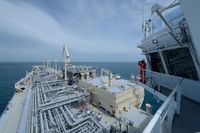On August 15, 2025, President Prabowo Subianto stood before Indonesia’s House of Representatives in Jakarta and laid out an ambitious economic vision for 2026. With an air of optimism, he declared, “Economic growth in 2026 is targeted to reach 5.4 percent or higher.” This target, paired with a bid to keep inflation at just 2.5 percent, signals the administration’s intent to steer Indonesia toward robust and stable growth. But as the president’s words echoed through the chamber, a very different story was unfolding among the country’s manufacturers—one marked by energy supply disruptions, mounting costs, and deepening anxieties about the future.
According to The Jakarta Post, the Industry Ministry has been inundated with complaints from private companies that depend on the government’s fixed natural gas price program, known as HGBT. Febri Hendri Antoni Arief, spokesperson for the ministry, voiced the concerns of manufacturers in sectors like ceramics, glass, steel, fertilizer, petrochemicals, and oleochemicals. “Energy costs make up a significant share of production expenses in these industries. Any increase in prices or cuts in HGBT supply erode margins, lower factory utilisation and, in the long run, deter investment, especially in energy-intensive manufacturing,” Febri explained in a statement on August 14.
The heart of the issue lies in the widening gap between government promises and on-the-ground realities. A presidential decree fixes the natural gas price at $6.5 per mmbtu, but state gas company PGN has been charging a tariff of $16.77 per mmbtu. This steep surcharge, coupled with supply disruptions, has left manufacturers squeezed and frustrated. “No party or institution should attempt to override the President’s order by raising the price above $6.5 or restricting the supply,” Febri insisted, underscoring the tension between policy and practice.
Indonesia’s industrial gas demand is estimated at 2,700 million standard cubic feet per day (mmscfd). Yet, the available HGBT supply is only 1,600 mmscfd, and about 900 mmscfd of that is allocated to state-owned enterprises (SOEs) like PLN and Pupuk Indonesia. Private manufacturers, often described as the backbone of Indonesia’s industrial base, are left with a shrinking share. “If the private sector’s share continues to shrink, the consequences will be immediate: reduced capacity, lower efficiency and potentially mass layoffs,” Febri warned.
The numbers paint a sobering picture. About 134,794 industrial workers rely on a stable HGBT supply. If volumes fall to just 48 percent of demand, a significant share of these jobs could be lost. The sectoral breakdown is stark: 43,058 jobs in ceramics, 31,434 in steel, 23,006 in petrochemicals, 12,928 in glass, 12,288 in oleochemicals, 10,420 in fertilizer, and 1,660 in rubber gloves hang in the balance. “These figures are a serious alarm. Every gas policy must weigh its impact on industrial sustainability and the livelihoods it supports,” Febri cautioned, as reported by The Jakarta Post.
Ministry data shows several sectors are already facing declining utilisation due to gas constraints. The national ceramics industry, for instance, averaged just 70 to 71 percent utilisation in the first half of 2025. The situation is particularly dire in West Java, Indonesia’s manufacturing heartland, where the ceramics industry is now limited to 48 percent of its HGBT gas allocation, down from the previous 60 percent set by PGN. In eastern regions, the cap is even lower at 40 percent.
From August 13 to August 31, only 48 percent of the HGBT gas volume can be used, while the remainder incurs a surcharge of $14.8 per mmbtu due to force majeure, according to Edy Suyanto, chairman of the Indonesian Ceramics Association (Asaki), as quoted by Bisnis. Suyanto has urged the government to resolve the disruption by ensuring adequate HGBT quotas. But the industry’s woes don’t end with energy supply. A surge in low-priced ceramic imports is putting additional pressure on domestic production, threatening to further erode the competitiveness of local manufacturers.
All of this unfolds against the backdrop of Prabowo’s sweeping economic targets. The government is not only aiming for 5.4 percent growth but also intends to bring the open unemployment rate down to between 4.44 and 4.96 percent, and the poverty rate to 6.5 to 7.5 percent. The Gini ratio—a measure of income inequality—is to be reduced to between 0.377 and 0.38, while the human capital index is targeted to reach 0.57. The farmers’ welfare index and formal job creation are also slated for improvement. President Prabowo expressed hope that by 2027 or 2028, Indonesia’s state budget will be deficit-free.
To back these ambitions, the 2026 Draft State Budget allocates Rp3,786.5 trillion (about $234.1 billion) for state spending, with revenue targeted at Rp3,147.7 trillion (around $194.6 billion). The projected deficit stands at Rp638.8 trillion (about $39.49 billion), or 2.48 percent of GDP. These are big numbers—and big promises. But as manufacturers see it, the devil is in the details. Without reliable and affordable energy, the path to economic transformation looks increasingly rocky.
Febri’s warning is particularly pointed when it comes to sectors critical to Indonesia’s future. “If supply disruptions persist, even critical sectors like fertilizer, which supports President Prabowo’s food self-sufficiency programme, could see output decline,” he noted. That’s a sobering possibility, given the government’s emphasis on food security and rural development as pillars of its broader economic agenda.
The tension between state-owned enterprises and private manufacturers is a recurring theme. SOEs like PLN and Pupuk Indonesia have been the largest beneficiaries of the HGBT program, while private industry often feels sidelined. “Private manufacturers, the backbone of the national industrial base, are often treated differently. This imbalance risks undermining the business climate,” Febri said. The message is clear: if the government hopes to reach its growth targets, it must ensure that policies are implemented fairly and that vital sectors aren’t left behind.
As the country looks ahead to 2026, the stakes couldn’t be higher. The president’s vision of a thriving, equitable, and resilient Indonesia is within reach—but only if the nuts and bolts of the economy, like energy supply and industrial policy, are aligned with that vision. Manufacturers, workers, and policymakers alike are watching closely, knowing that the decisions made today will shape Indonesia’s future for years to come.
For now, optimism and concern walk hand in hand. The government’s economic targets are bold, but the challenges faced by industry serve as a sobering reminder that growth is never guaranteed. With livelihoods at stake and the clock ticking toward 2026, all eyes are on Jakarta’s corridors of power—and on the factories and workshops that keep Indonesia’s economy humming.


